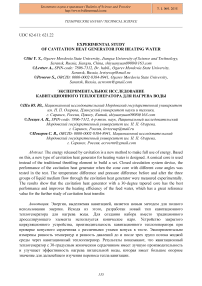Experimental study of cavitation heat generator for heating water
Автор: Shi Yuan Yuan, Levtsev Aleksei, Povorov Sergei
Журнал: Бюллетень науки и практики @bulletennauki
Рубрика: Технические науки
Статья в выпуске: 9 т.4, 2018 года.
Бесплатный доступ
The energy released by cavitation is a new method to make full use of energy. Based on this, a new type of cavitation heat generator for heating water is designed. A conical core is used instead of the traditional throttling element to build a set. Closed circulation system device, the performance of the cavitation heat generator when the cone core with different cone angles was tested in the test. The temperature difference and pressure difference before and after the three groups of liquid medium flow through the cavitation heat generator were measured experimentally. The results show that the cavitation heat generator with a 30-degree tapered core has the best performance and improves the heating efficiency of the feed water, which has a great reference value for the further study of cavitation heat transfer.
Cavitation heat generator, tapered core, experimental, enhanced heat transfer
Короткий адрес: https://sciup.org/14112254
IDR: 14112254 | УДК: 62-611: | DOI: 10.5281/zenodo.1418719
Список литературы Experimental study of cavitation heat generator for heating water
- Cai J., Li X., Liu B. Effect of cavitating flow on forced convective heat transfer: a modeling study//Chinese science bulletin. 2014. V. 59. №14. P. 1580-1590.
- Sivakumar M., Pandit A. B. Wastewater treatment: a novel energy efficient hydrodynamic cavitational technique//Ultrasonics sonochemistry. 2002. V. 9. №3. P. 123-131.
- Chand R., Bremner D. H., Namkung K. C., Collier P. J., Gogate P. R. Water disinfection using the novel approach of ozone and a liquid whistle reactor//Biochemical Engineering Journal. 2007. V. 35. №3. P. 357-364.
- Kelkar M. A., Gogate P. R., Pandit A. B. Intensification of esterification of acids for synthesis of biodiesel using acoustic and hydrodynamic cavitation//Ultrasonics Sonochemistry. 2008. V. 15. №3. P. 188-194.
- Park K. A., Bergles A. E. Ultrasonic enhancement of saturated and subcooled pool boiling//International journal of heat and mass transfer. 1988. V. 31. №3. P. 664-667.
- Cai J., Huai X., Yan R., Cheng Y. Numerical simulation on enhancement of natural convection heat transfer by acoustic cavitation in a square enclosure//Applied Thermal Engineering. 2009. V. 29. №10. P. 1973-1982.
- Pourkarimi Z., Rezai B., Noaparast M. Effective parameters on generation of nanobubbles by cavitation method for froth flotation applications//Physicochemical Problems of Mineral Processing. 2017. V. 53. №2.
- Li C., Yan Z. Analysis of Cavitation of Cryogenic Fluid Passing through Bent Pipe//Cryogenics Engineering. 2008. №2. P. 4-9.
- Zhu Jiakai, Wang Yihao, Yu Liu, et al. Visualization Experimental Study on Unsteady Shedding Process of Liquid Nitrogen Cavitation//Cryogenic Engineering. 2018. №2. P. 1-6.
- Левцев А. П., Макеев А. Н., Кудашева О. В. Кавитатор для выделения тепла в жидкости: RU2015145776A. Дата публикации: 25.04.2017 г. Бюл. №12.


